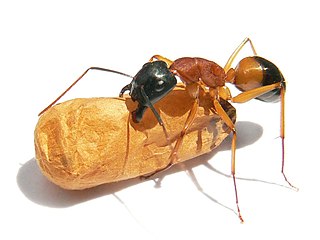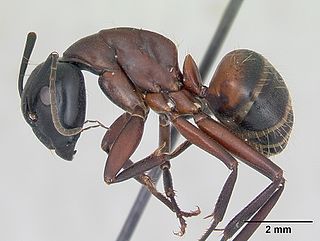
Lasius is a genus of formicine ants. The type species for this genus is the black garden ant, Lasius niger. Other major members, which live in drier heathland, are the cornfield ant, L. neoniger, and L. alienus. Other species include the temporary social parasites of the L. mixtus group and the hyper-social parasite Lasius fuliginosus. Lasius flavus is also a commonly seen species, building grassy hillocks in undisturbed pasture. In the Alps, these mounds – always aligned east to catch the first rays of the rising sun – have been traditionally used by goatherds as natural compasses. Species in the subgenus Acanthomyops, in particular L. interjectus and L. claviger, are commonly known as citronella ants due to their citronella-like smell.

Carpenter ants are large ants indigenous to many forested parts of the world.

The banded sugar ant, also known as the sugar ant, is a species of ant native to Australia. A member of the genus Camponotus in the subfamily Formicinae, it was described by German entomologist Wilhelm Ferdinand Erichson in 1842. Its common name refers to the ant's liking for sugar and sweet food, as well as the distinctive orange-brown band that wraps around its gaster.

The black carpenter ant is one of the largest and most common species of carpenter ant native to the central and eastern United States as well as eastern Canada.

Solenopsis molesta is the best known species of Solenopsisthief ants. They get their names from their habit of nesting close to other ant nests, from which they steal food. They are also called grease ants because they are attracted to grease. Nuptial flight in this species occur from late July through early fall.

Camponotus vagus is a species of large, black, Palaearctic carpenter ant with a wide range that includes much of Europe, a large area of Asia, and part of Africa.

The green-head ant is a species of ant that is endemic to Australia. It was described by British entomologist Frederick Smith in 1858 as a member of the genus Rhytidoponera in the subfamily Ectatomminae. These ants measure between 5 and 7 mm. The queens and workers look similar, differing only in size, with the males being the smallest. They are well known for their distinctive metallic appearance, which varies from green to purple or even reddish-violet. Among the most widespread of all insects in Australia, green-head ants are found in almost every Australian state, but are absent in Tasmania. They have also been introduced in New Zealand, where several populations have been established.

Camponotus modoc or western carpenter ant is a black carpenter ant with dark red legs. Workers range in size from 7 to 13 mm.

Camponotus japonicus, commonly known as the Japanese carpenter ant, is a species of ant native to eastern Asia. It is black, and one of the largest ants. A nest has about ten to thousands of individuals, and it can be a pest when it enters households or protects aphids. There are several subspecies of this ant in different areas of Asia, with the largest of the species being located in northern China.

Liometopum occidentale, also called the velvety tree ant, is a species of ant in the subfamily Dolichoderinae. Liometopum occidentale is often mistaken for carpenter ants by homeowners and pest management professionals. This mistaken identity is due to morphological and behavioral characteristics they share with carpenter ants; namely polymorphic workers, a smooth convex thoracic profile, and the tendency to excavate wood. Consequently, their importance as structural pests may be greatly under reported, especially in California, Oregon, and Washington, United States.

Liometopum luctuosum is a species of ant in the subfamily Dolichoderinae. Liometopum luctuosum is often mistaken for carpenter ants by homeowners and pest management professionals. This mistaken identity is due to morphological and behavioral characteristics they share with carpenter ants; namely polymorphic workers, a smooth convex thoracic profile, and the tendency to excavate wood. L. luctuosum are also often confused with Tapinoma sessile since they have the same coloration, are similar in size, and produce an alarm pheromone with a very similar odor. Consequently, their importance as structural pests may be greatly under reported, especially in California, Oregon, and Washington, United States.
Camponotus reburrus is a species of carpenter ants in the subfamily Formicinae. It is known only from northeastern Ecuador. C. reburrus apparently has an obligatory relationship with the ant plants Cecropia membranacea, Cecropia herthae and Cecropia marginalis. The workers are relatively small and hairy, it does not appear to have major workers. It is similar to Camponotus balzani which also lives in Cecropia spp..

Liometopum apiculatum is a species of ant in the subfamily Dolichoderinae. Liometopum apiculatum ants are found in arid and semi-arid regions of southwestern United States and Mexico to Quintana Roo.

Forelius pruinosus, commonly known as the high noon ant, is a species of ant in the genus Forelius. Described by Roger in 1863, the species is endemic to North America and has been recently observed in Latin America.

Camponotus herculeanus is a species of ant in the genus Camponotus, the carpenter ants, occurring in Northern Eurasia, from Norway to Eastern Siberia, and North America. First described as Formica herculeana by Linnaeus in 1758, the species was moved to Camponotus by Mayr in 1861.

Camponotus floridanus, or Florida carpenter ant, is a species of ant in the genus Camponotus. First described as Formica floridana by Buckley in 1866, the species was moved to Camponotus by Mayr in 1886. The ant is widespread in Florida and occurs as far north as North Carolina and as far west as Mississippi.

Camponotus socius, the sandhill carpenter ant, is a large species of ant in the genus Camponotus. It was first described by Julius Roger (1863), based on specimens from Brazil - however these can be considered highly dubious as the location where the type specimens were collected (Amazonas) does not fit the known ecology of the species within North America, where it exhibits traits typical of a native species. It is well adapted to the sandy soils of xeric woodlands found within the coastal plains of the southeastern United States. Its range includes the US states of Georgia, Alabama, Florida, North and South Carolina and Mississippi.

The black-headed sugar ant, also known as the brown sugar ant, is a species of Formicinae ant endemic to Australia. Found throughout most states, the species is a member of the genus Camponotus, a cosmopolitan genus of ants commonly known as carpenter ants. It was formally described and named by British entomologist Frederick Smith in 1858. These ants are characterised by their black head, reddish-brown mesosoma and black gaster, which can change in colour.

Novomessor ensifer is a species of ant endemic to Mexico. A member of the genus Novomessor in the subfamily Myrmicinae, it was first described by Swiss entomologist Auguste Forel in 1899. N. ensifer was originally a part of the genus Aphaenogaster until a recent phylogenetic study concluded that Novomessor was genetically distinct and should be separated. The ant is a medium-sized species, measuring 5.5 to 10 millimetres. The ant is ferruginous-colored in some certain parts of the body, and small workers (nanitics) in incipient colonies are noticeably different in color and body structure.

Camponotus ligniperda, the brown-black carpenter ant, is a common species of carpenter ant distributed widely throughout Europe. Found in a variety of woodland habitats, they commonly nest on the ground in dry tree stumps, dead fallen trees, or beneath stones and wooden logs that are partially buried. C. ligniperda is an ecologically dominant species wherever it is found due to both its large size and particularly aggressive nature.



















